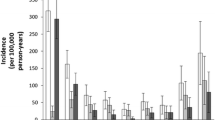Abstract
We conducted a case-control study to identify risk factors for fractures of the distal radius and proximal humerus. Subjects were selected from women aged 45 and over with distal radius and proximal humerus fractures, resulting from minor trauma. Two age- and gender-matched controls for each case were selected from patients who subsequently visited the same clinic for treatment of conditions other than fractures. Questionnaires including anthropometric data, past and current physical activity, and lifestyle were sent by mail to both subjects and controls. A total of 140 women with distal radius fractures (mean age 67.4 years) and 242 controls were analyzed. Falls during the previous year were a significant risk factor, while futon use (instead of bed use) before fracture was a protective factor for distal radius fractures. A total of 37 women with proximal humerus fractures (mean age 76.3 years) and 67 controls were analyzed. Weight loss was a significant risk factor, while greater frequency of going outside significantly decreased the risk of proximal humerus fracture. There was no significant correlation with eating habits, milk and alcohol consumption, or smoking to the risk of either fracture.
Similar content being viewed by others
References
Seeley DG, Browner WS, Nevitt MC, Genant HK, Scott JC, Cummings SR (1991) Which fractures are associated with low appendicular bone mass in elderly women? The Study of Osteoporotic Fractures Research Group. Ann Int Med 115:837–842
Marcus R, Wong M, Heath H 3rd, Stock JL (2002) Antiresorptive treatment of postmenopausal osteoporosis: comparison of study designs and outcomes in large clinical trials with fracture as an endpoint. Endocrine Rev 23:16–37
Hagino H, Yamamoto K, Ohshiro H, Nakamura T, Kishimoto H, Nose T (1999) Changing incidence of hip, distal radius, and proximal humerus fractures in Tottori Prefecture, Japan. Bone 24:265–270
Aoyagi K, Ross PD, Davis JW, Wasnich RD, Hayashi T, Takemoto T (1998) Falls among community-dwelling elderly in Japan. J Bone Miner Res 13:1468–1474
Iga T, Dohmae Y, Endo N, Takahashi HE (1999) Increase in the incidence of cervical and trochanteric fractures of the proximal femur in Niigata Prefecture, Japan. J Bone Miner Metab 17:224–231
Suzuki T, Yoshida H, Hashimoto T et al. (1997) Case-control study of risk factors for hip fractures in the Japanese elderly by a Mediterranean Osteoporosis Study (MEDOS) questionnaire. Bone 21:461–467
Fujiwara S, Kasagi F, Yamada M, Kodama K (1997) Risk factors for hip fracture in a Japanese cohort. J Bone Miner Res 12:998–1004
Melton LJ 3rd (1995) Epidemiology of fractures. In: Riggs BL, Melton LJ 3rd (eds) Osteoporosis. Etiology, diagnosis, and management. Lippincott-Raven, Philadelphia, pp 225–247
Mallmin H, Ljunghall S, Persson I, Bergstrom R (1994) Risk factors for fractures of the distal forearm: a population-based case-control study. Osteoporos Int 4:298–304
Winner SJ, Morgan CA, Evans JG (1989) Perimenopausal risk of falling and incidence of distal forearm fracture. BMJ 298:1486–1488
Hemenway D, Colditz GA, Willett WC, Stampfer MJ, Speizer FE (1988) Fractures and lifestyle: effect of cigarette smoking, alcohol intake, and relative weight on the risk of hip and forearm fractures in middle-aged women. Am J Public Health 78:1554–1558
Hernandez-Avila M, Colditz GA, Stampfer MJ, Rosner B, Speizer FE, Willett WC (1991) Caffeine, moderate alcohol intake, and risk of fractures of the hip and forearm in middle-aged women. Am J Clin Nutr 54:157–163
Feskanich D, Willett WC, Stampfer MJ, Colditz GA (1996) Protein consumption and bone fractures in women. Am J Epidemiol 143:472–479
Kelsey JL, Browner WS, Seeley DG, Nevitt MC, Cummings SR (1992) Risk factors for fractures of the distal forearm and proximal humerus. The Study of Osteoporotic Fractures Research Group. Am J Epidemiol 135:477–489
Ivers RQ, Cumming RG, Mitchell P, Peduto AJ (2002) Risk factors for fractures of the wrist, shoulder and ankle: the Blue Mountains Eye Study. Osteoporos Int 13:513–518
Silman AJ (2003) Risk factors for Colles’ fracture in men and women: results from the European Prospective Osteoporosis Study. Osteoporos Int 14:213–218
O’Neill TW, Marsden D, Adams JE, Silman AJ (1996) Risk factors, falls, and fracture of the distal forearm in Manchester, UK. J Epidemiol Commun Health 50:288–292
Nevitt MC, Cummings SR (1993) Type of fall and riskudy of osteoporotic fractures. The Study of Osteoporotic Fractures Research Group. J Am Geriatr Soc 41:1226–1234
Lee SH, Dargent-Molina P, Breart G (2002) Risk factors for fractures of the proximal humerus: results from the EPIDOS prospective study. J Bone Miner Res 17:817–825
Woolf AD, Åkesson K (2003) Preventing fractures in elderly people. BMJ 327:89–95
Acknowledgements
The authors thank Akira Fukushima, Yu Ohsako, Masaaki Shimizu, and Noboru Yamagata, for their help and support. This study was supported by a Grant-in-Aid for Scientific Research C (14571378) from the ministry of Education, Culture, Sports, Science, and Technology of Japan.
Author information
Authors and Affiliations
Corresponding author
Rights and permissions
About this article
Cite this article
Hagino, H., Fujiwara, S., Nakashima, E. et al. Case-control study of risk factors for fractures of the distal radius and proximal humerus among the Japanese population. Osteoporos Int 15, 226–230 (2004). https://doi.org/10.1007/s00198-003-1543-8
Received:
Accepted:
Published:
Issue Date:
DOI: https://doi.org/10.1007/s00198-003-1543-8




